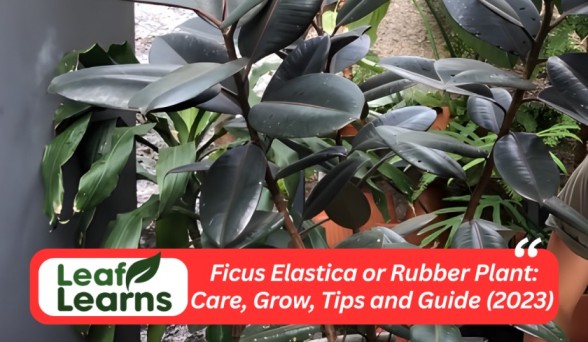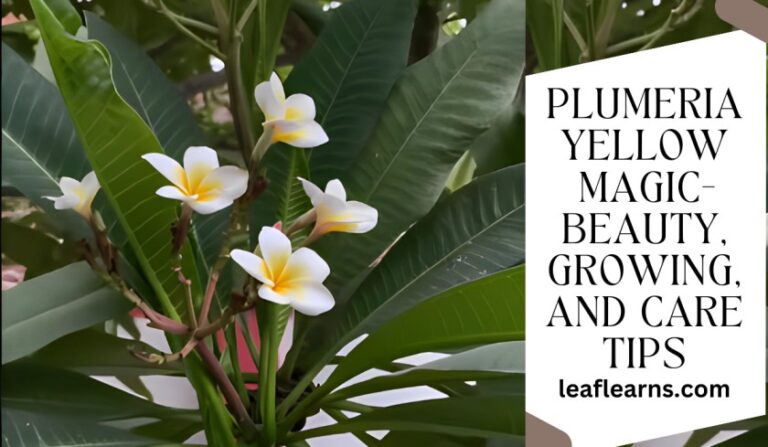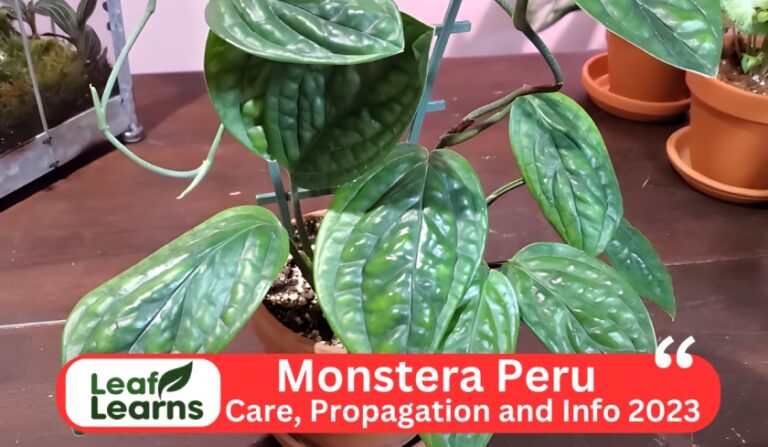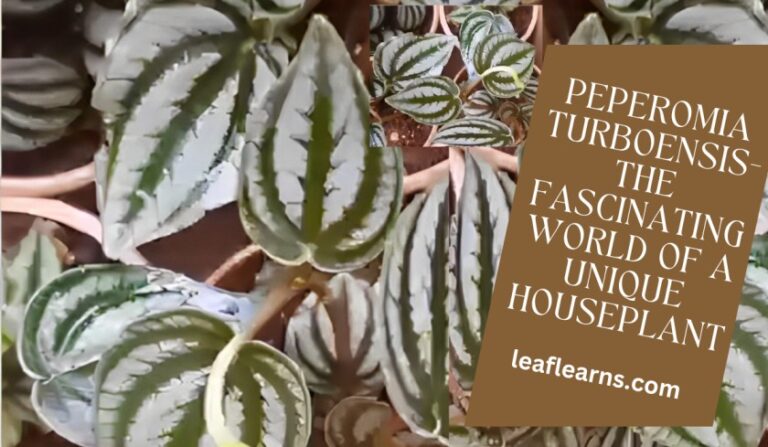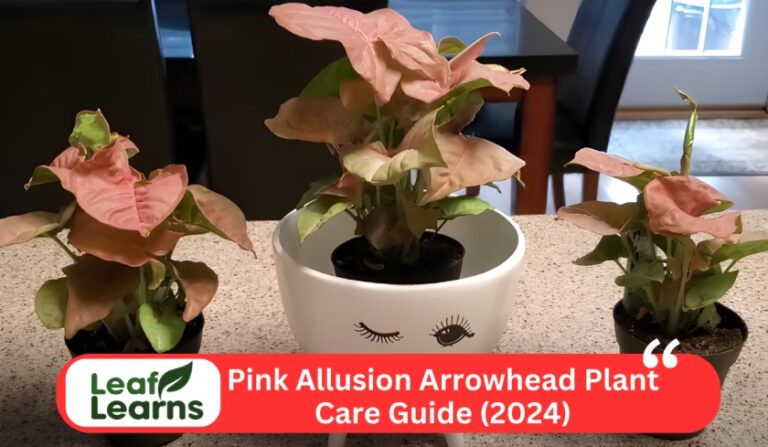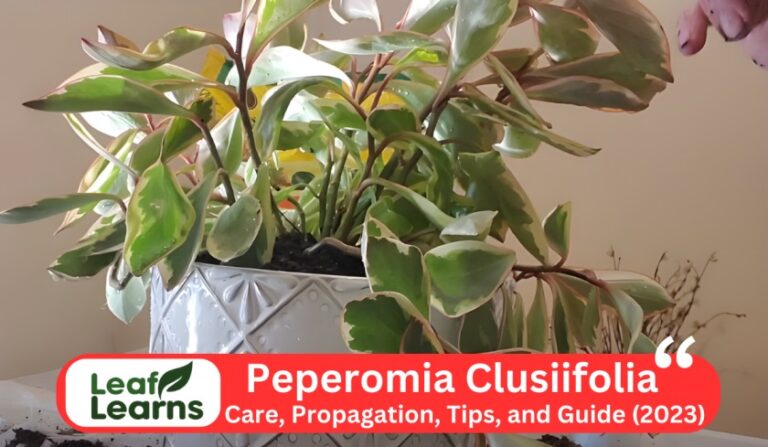Aeonium Kiwi: Tips, Care and Growing Methods
Aeonium haworthii ‘Kiwi,’ also known as the Kiwi succulent or Aeonium kiwi, is a captivating plant native to the Canary Islands and Morocco, but it thrives in regions with similar climates like Southern California.
Its tricolor, rosette-forming foliage is a visual delight, featuring leaves variegated in vibrant shades of yellow and green. When basked in sunlight, the tips of its leaves take on a brilliant red hue, making it an instant showstopper.
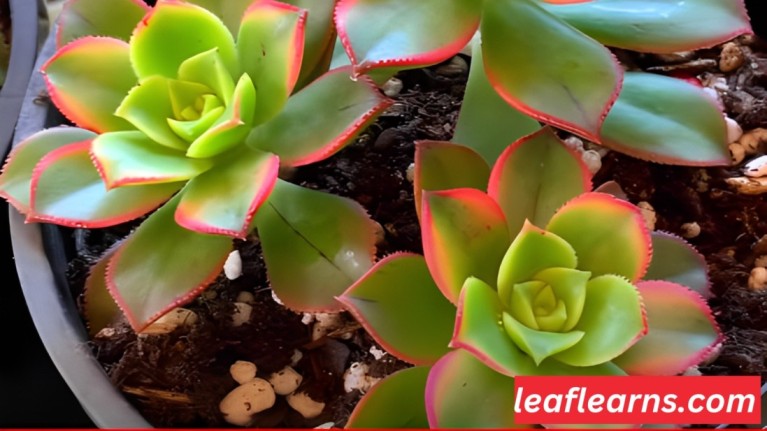
While it’s often mistakenly called Haworth’s Aeonium or Aeonium Pinwheel due to its resemblance to Aeonium haworthii, it’s actually a cultivated hybrid variety.
These succulents, like many Aeonium species, experience active growth from winter to spring and go dormant during the scorching summer.
They typically reach heights of up to three feet and shed lower leaves as they mature. Aeoniums, with their glossy rosettes and striking foliage, are natives of Madeira, the Canary Islands, and North Africa, making them a great choice for summer bedding or as houseplants in temperate regions.
| Common name | Aeonium Kiwi, Kiwi Succulent |
| Scientific Name | Aeonium haworthii ‘Kiwi’ |
| Family | Cyatheaceae |
| Distribution | Hybrid succulent, possibly originating in California |
| Growth habitat | Rosette-forming succulent |
| Size | grows to 6-12 inches (15-30 cm) in height |
| Leaf shape | Spoon-shaped, fleshy leaves |
| Leave colour | Variegated with shades of green, pink, and cream |
| Flower | Tall spikes with small, yellow flowers |
| Foliage type | Evergreen |
| Propagations | Stem cuttings or offsets |
| Light requirement | Full sun to partial shade |
| Soil requirement | Well-draining succulent mix |
| Watering Need | Allow the soil to dry out between waterings |
| Uses | Container gardens, succulent arrangements |
| Toxicity | Non-toxic to humans and pets |
| Maintenance | Low maintenance, minimal pruning required |
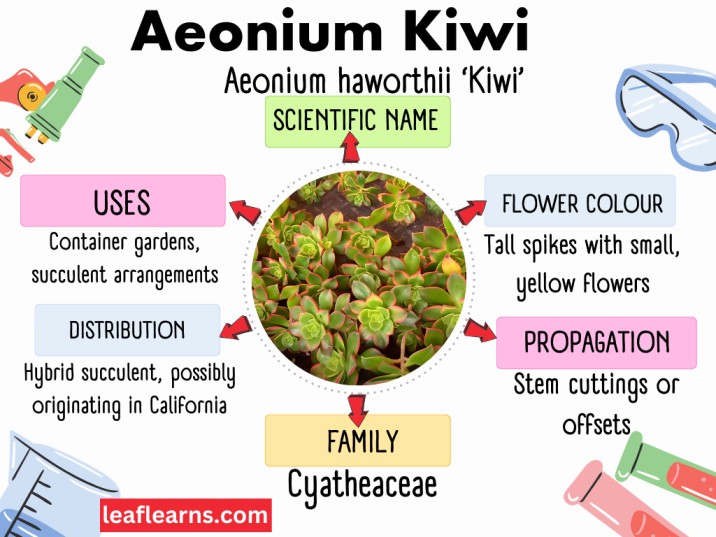
Contents
- 1 Aeonium Kiwi Care
- 2 Pruning
- 3 How To Propagate Aeonium Kiwi
- 4 Tips for successful propagation
- 5 Troubleshooting
- 6 Toxicity
- 7 Potting
- 8 Lifespan
- 9 Repotting
- 10 Aeonium Kiwi Varieties
- 11 Overwintering And Summer Dormancy
- 12 Turning yellow and how to address it
- 13 Common Problems
- 14 Pests
- 15 Disease
- 16 Suggested Uses
- 17 Caring and Growing Stretegy
- 18 Propagating and Ensuring the Health of Aeonium Kiwi: Key Considerations
- 19 Conclusion
- 20 FAQs
Aeonium Kiwi Care
Light
To grow, this plant Care needs lots of light. When positioned in an area that receives strong, indirect sunlight, these gorgeous succulents, with their vivid green and pink leaves imitating the colours of a tropical fruit, perform at their best.
They can withstand some shade, but they will develop more vibrantly and healthily if you give them at least six hours of sunshine every day. If you want to guarantee that your plant receives the best care and maintains a magnificent look, place them near a window that gets plenty of sunshine or in a location where they may enjoy the soft glow of filtered sunlight.
Temperature
The most important aspect of caring for plant is to keep its temperature just right. The best temperature range for these lovely plants is between 65°F and 75°F (18°C and 24°C).
They are very vulnerable to temperature extremes, therefore it’s important to protect them from frost and severe heat because they can cause permanent harm.
The Aeonium-Kiwi is a lovely addition to temperate gardens and indoor spaces since it requires a steady temperature setting to maintain the brilliant colours of its leaves.
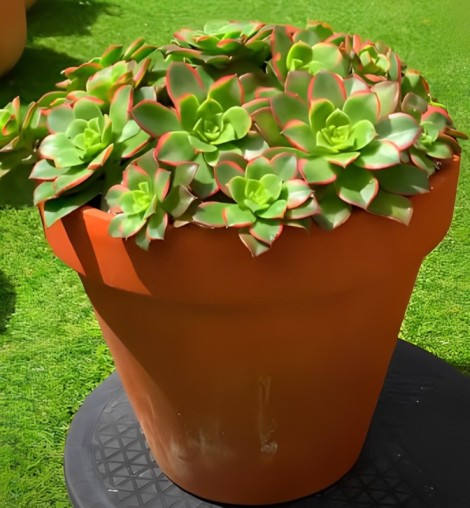
Soil And Transplanting
For the health of this unique succulent, appropriate Aeonium-Kiwi care includes fertilising the soil and transplanting. These colourful, rosette-shaped plants require a well-draining succulent mix to avoid wet roots and root rot.
Make sure the new container for the Aeonium has enough drainage holes, and use a potting soil specifically made for succulents or augment standard potting soil with perlite or sand to enhance drainage.
The best time to transplant is in the spring when the plant is actively developing and can more easily adapt to its new environment. Your Plant will flourish with the correct soil and transplanting methods, showing its alluring combination of green, pink, and cream colours.
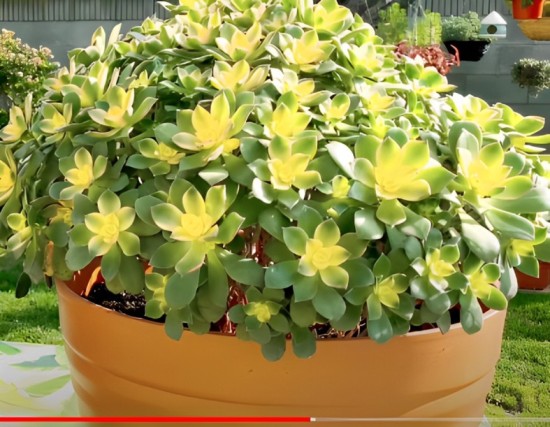
Watering And Feeding
Maintaining the health of plant requires proper feeding and watering. With their vivid green and pink variegated foliage, these alluring succulents demand a balanced approach to flourish. It’s crucial to achieve a balance while watering plants.
Allowing the top inch of soil to dry before watering is advised since your plant need their soil to be regularly wet but not soggy. In order to encourage their development and preserve their distinctive colour, they also benefit from a monthly injection of balanced liquid fertilizer that has been diluted to half strength during the growing season, which runs from early spring to early fall.
To avoid overwatering and maintain the healthiest possible condition for these magnificent succulents throughout the dormant winter months, it’s advisable to limit both watering and feeding.
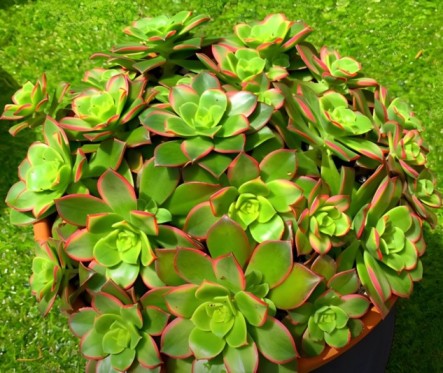
Humidity
For best maintenance, this plant a distinctive and colourful succulent, needs careful attention to humidity conditions. While most of these hardy plants can tolerate drought, they do need a certain amount of mild humidity to grow.
Particularly in dry or arid areas, maintaining a humidity level between 40% and 60% is good for this plant. Consider using a humidity tray or setting up a tiny humidifier next to the plant in areas with extremely low humidity levels to make sure it gets the moisture it needs.
Aeoniums are prone to root rot, so take care not to overwater them. Your plant will be able to display its gorgeous, variegated leaves and remain healthy if you maintain the right humidity levels and watering practises.
Fertilization
The maintenance of the lovely succulent Aeonium-Kiwi, which is renowned for its eye-catching variegated leaves, depends heavily on fertilization. It’s crucial to follow a balanced feeding schedule to maintain the best development and vitality of this alluring plant.
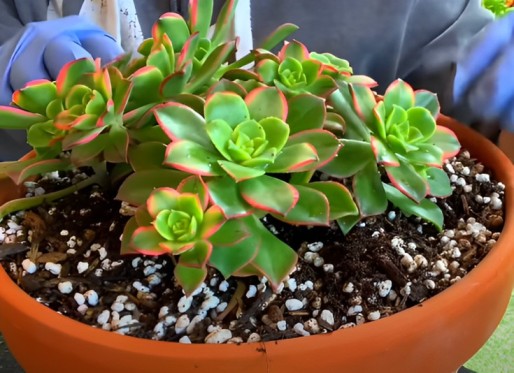
Every four to six weeks throughout the active growth season, which is normally in the spring and summer, apply a well-balanced, diluted liquid fertilizer. It’s crucial to avoid overfertilizing of this plant because of its low food needs, which can result in excessive growth and the loss of the plant’s compact, bushy appearance.
The stunning colour and distinctive rosette structure of this plant may be fully appreciated by fans by carefully controlling fertilization.
Pruning
Aeonium-Kiwi pruning is an easy yet crucial operation for keeping this unusual succulent healthy and beautiful. Trim the lanky or overgrown stems to promote compact growth and protect your plant from becoming top-heavy in order to maintain its health.
Make accurate cuts immediately above a leaf node with clean, sharp pruning shears so that the plant may produce new growth from that spot.
In addition, pruning spent flower stalks and dead or withered leaves encourages robust regrowth while preventing disease, ensuring that your plant maintains its eye-catching blend of brilliant green, pink, and yellow foliage.
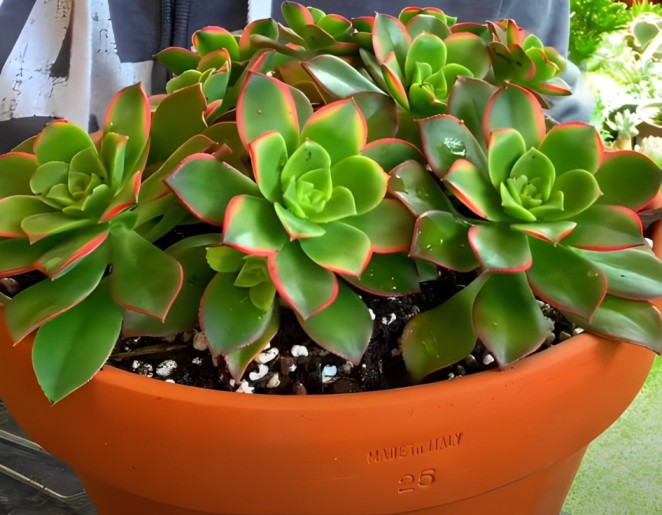
Flowering
The appealing succulent plant Aeonium-Kiwi, sometimes referred to as “Kiwi Flowering,” is coveted for its eye-catching look and endearing rosette structure. This unusual succulent has vivid, variegated leaves that resemble ripe kiwi fruit and are colours of pale green, cream, and pink.
This plant develops beautiful clusters of tiny, star-shaped yellow flowers as it ages, enhancing the attractiveness of its already stunning leaves. It is a favourite of both experienced and novice succulent growers due to its compact growth pattern and minimal care needs, making it the perfect plant to give a dash of exotic beauty to any indoor or outdoor garden.
How To Propagate Aeonium Kiwi
Offsets
Offsets of that plant succulent plant, often known as “pups,” are little wonders that grow from the plant’s base. With its leaves showing tones of green, pink, and creamy white, these offsets present a wonderful combination of vivid colours.
As they mature, they become separate plants and take on the alluring rosette shape of the Aeonium-Kiwi. These offsets not only enhance the plant’s aesthetic appeal but also provide a means of multiplication, enabling fans to grow more Aeonium-Kiwi specimens and spread word of their breathtaking beauty. This plant offsets are a lovely addition to any collection of succulents because of their small stature and eye-catching hue.

Cuttings
Due to its eye-catching and distinctive look,cuttings have gained popularity among succulent fans. The rosettes on these cuttings, which range in colour from pinkish-red to pale green and resemble vivid kiwi fruit, are an alluring combination of hues. Aeonium-Kiwi cuttings, renowned for their simplicity in propagation, flourish in sunny, well-draining soil.
Their small stature makes them perfect for container gardening or as striking accents in rock gardens, giving any collection of succulents a hint of exotic intrigue. This plant cuttings need little maintenance and give a distinctive appearance to any yard or indoor succulent arrangement.
Tips for successful propagation
Here are some tips for successful propagation:
Select Healthy Parent Plants
To begin with, choose mature, healthy Aeonium-Kiwi plants as your parent plants for division.
Choose the Right Time
When the plant is actively developing, in the spring or early summer, is the optimal time to propagate.
Use Stem Cutting
Stem cuttings work better for aeonium-kiwi propagation than seeds do.
Prepare Sharp Tools
Make clean cuts with clean, sharp scissors or pruning shears to lower the chance of infection.
Cut at the Right Spot
Just above a leaf node, cut a healthy stem from the parent plant, making sure your cutting is at least 3–4 inches long.
Allow Cuttings to Callus
For a few days, keep the cuttings in a dry, shady spot to allow the cut ends to callus. When planting, this helps prevent rotting.
Use Well-Draining Soil
To avoid soggy roots, plant the callused cuttings in a mix for succulents or cacti that drains well.
Water Sparingly
To prevent root rot, water the cuttings sparingly after planting and wait a while before watering again.
Provide Indirect Sunlight
To avoid sunburn, place the newly planted cuttings in partial shade or indirect sunlight.
Maintain Humidity
Cover the cuttings with a transparent plastic bag or a plastic dome to preserve humidity and promote root growth.
Monitor Growth
Keep a look out for new growth on the cuttings, which shows that they have developed roots.
Transplant Carefully
Transplant the cuttings into larger pots or their final location as soon as their roots have established and they are starting to grow.
Fertilize Sparingly
Aeonium As kiwi grows slowly, apply a balanced, diluted fertiliser during the growing season.
(spring to fall).
Protect from Frost
The eonium kiwi is not resistant to frost. In chilly climates, bring potted plants indoors or give frost protection.
Prune for Shape
Prune your plant as it ages to keep it in the right size and form.
Repot When Necessary
When your plant outgrows its pot or the soil loses all of its nutrients, repot it.
Watch for Pests and Diseases:
Check your plants frequently for symptoms of pests like mealybugs or aphids, and treat them right away if necessary.
Share Your Success:
A succulent garden can benefit greatly from the addition of this plant. Your successful propagation should be shared with other enthusiasts!
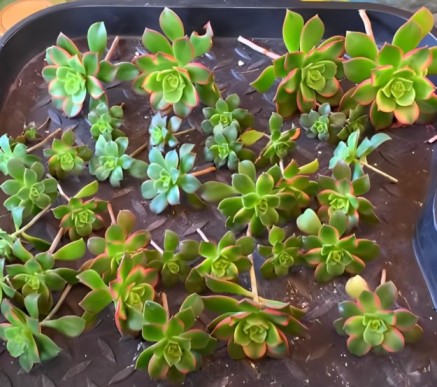
Troubleshooting
Aeonium The unique succulent kiwi may have a number of problems. Reduce watering if leaves become brown or mushy since this indicates overwatering. On the other hand, wrinkly or shrivelled leaves indicate dryness; gradually increase watering. Make sure the soil has good drainage and gets enough sunshine.
A balanced fertiliser is required since yellowing leaves might be a sign of nutritional inadequacies. Trim lanky growth to provide a more compact look. Regularly check for pests like aphids or mealybugs, and treat any infestations right away.
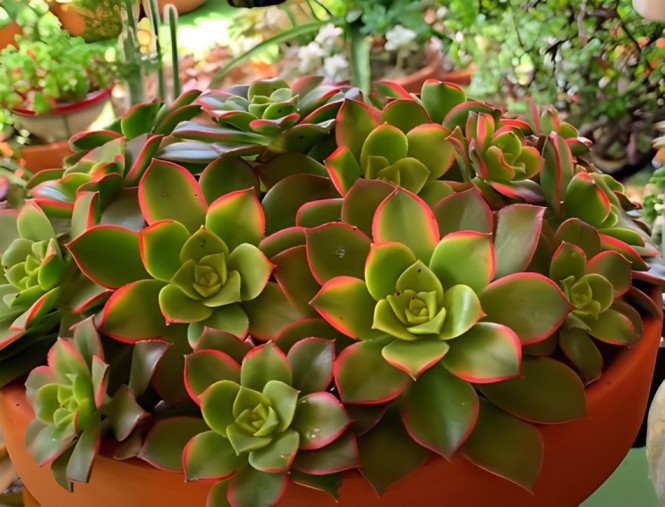
Toxicity
Popular succulent Aeonium is not thought to be particularly hazardous to people or animals, but care should still be taken. Some people may get skin rashes or allergic reactions from the plant’s sap.
It might cause moderate stomach discomfort if consumed. Even while it’s typically not fatal, it’s advisable to keep your plant away from curious kids and dogs to avoid any potential pain.
Potting
The alluring succulent aeonium-kiwi thrives in well-draining soil and containers, so growing it in potting is the best option. To guarantee optimum drainage, use a mixture of cactus or succulent soil, and choose a container with drainage holes to avoid overwatering.
To prevent root rot, place in an area with indirect, bright light. With the right potting care, your plant’s vivid green and pinkish tones will bloom.
Lifespan
Aeonium-Kiwi, a rare kind of succulent, lives for three to five years on average. It may survive longer with the right care and in a good environment, perhaps even up to a decade.
This lovely plant is a favourite among succulent fans because of its rosette-shaped leaves with gorgeous variegated colours. Its longevity can be increased with regular trimming and defence against harsh elements.
Repotting
Choose a slightly bigger container with adequate drainage for repotting Aeonium-Kiwi. Remove the plant from its present container gently, being careful not to harm the vulnerable roots. Remove any broken or encroaching roots.
Put the plant in the new pot, fill it with succulent soil that drains well, and water it just occasionally. Allow the plant to get used to its new surroundings and provide indirect sunshine to promote wholesome development.
Aeonium Kiwi Varieties
The lovely succulent plants known as Aeonium-Kiwi variants are distinguished by their remarkable beauty. These hybrids have rosettes of fleshy, variegated leaves that are pink and green in colour and resemble the kiwi fruit.
Low-maintenance plant are wonderful additions to indoor plant collections and gardens. They are a favourite among succulent fans because of their distinctive colours and small size.
Overwintering And Summer Dormancy
The endemic succulent of the Canary Islands, Aeonium plant, behaves differently according on the time of year. Since it is not cold-hardy, it is essential to protect it from frost throughout the winter.
It reaches a semi-dormant condition during this time, need less watering. In contrast, it goes through a natural hibernation in the summer, losing its lower leaves to preserve water.
Turning yellow and how to address it
Aeonium kiwi plants might indicate a number of different problems. Make sure the soil dries up between waterings because overwatering is a regular offender. It’s important to get enough sunshine; give bright, indirect lighting.
Look for insects like aphids and use neem oil to cure them if you find any. Repotting the plant in soil with good drainage might also improve its health. Restore the brilliant green colour by routinely monitoring and adjusting treatment.
Common Problems
The main problem is overwatering, which causes root rot and wilting. Lack of sunshine can result in pale colouring and lanky growth.
The plant could become infested with pests like mealybugs and aphids.
This plant may be kept healthy and vibrant with proper maintenance, well-draining soil, and moderate watering.
Pests
Although the succulent plant Aeonium-Kiwi is largely pest-resistant, it may occasionally come into contact with a few common pests. The most prevalent pests that munch on the delicate leaves of this plant are aphids and mealybugs.
Regularly check your plant leaves for indications of infestation, and then use a soft brush or a mild soap and water solution to carefully remove any bugs you find. The health and beauty of the plant may be preserved with proper maintenance and a watchful eye.
Disease
Aeonium-Kiwi disease, often known as “leaf curl” or “succulent rot,” commonly affects plants. It causes the plant’s leaves to curl, get discoloured, and weaken before eventually withering and decaying.
The main causes of this illness are overwatering, inadequate drainage, or fungus infections. To protect the health of your plant succulents, preventative measures include well-draining soil, moderate watering, and appropriate air circulation.
Suggested Uses
The stunning succulent with its vivid green and pink variegated leaves, has many uses in gardening and interior design.
Due to its limited growth, it is perfect for planting in containers and brightens patios and balconies. Due of its drought resistance, it also does well in xeriscapes and rock gardens. This plant is a popular choice for terrariums and decorative arrangements due to its distinctive look.
Caring and Growing Stretegy
This plant also known as Aeonium Perkarneum Kiwi or simply Aeonium-Kiwi, is a stunning succulent known for its variegated foliage that resembles the vibrant colors of a kiwi fruit.
When it comes to care, it’s essential to provide the right conditions for this unique plant. This plant thrives when grown indoors, making it an excellent choice for succulent enthusiasts who prefer to keep their plants inside.
To ensure its well-being, place it in a location where it can receive plenty of bright, indirect sunlight. This succulent prefers well-draining soil and should be watered sparingly, allowing the soil to dry out between waterings. Aeonium is not particularly cold-hardy, so protect it from frost and extreme cold temperatures. Regular pruning can help maintain its height and shape while encouraging bushier growth.
Propagating and Ensuring the Health of Aeonium Kiwi: Key Considerations
When it comes to propagating Aeonium Kiwi, you can do so through stem cuttings. Allow the cuttings to callus for a few days before planting them in a well-draining succulent mix. Keep the soil lightly moist until new growth appears. Be cautious if you have cats, as it is considered toxic to them.
To sum it up, caring for Aeonium-Kiwi involves providing it with the right light, soil, and watering conditions, as well as protecting it from cold temperatures. With proper care, this variegated succulent can brighten up your indoor space and thrive for a considerable part of its lifespan.
Conclusion
In caring for Aeonium Kiwi, focus on providing enough light, maintaining a stable temperature, using well-draining soil, and proper watering. Pay attention to humidity, prune when needed, and troubleshoot issues like yellowing leaves or pests.
Propagation through offsets and cuttings allows sharing the beauty of Aeonium Kiwi. With proper care, it becomes a charming addition to gardens, containers, and ornamental arrangements, adding exotic allure to indoor or outdoor spaces.
FAQs
Why are the leaves falling off my Aeonium Kiwi?
This typically indicates overwatering. Don’t water your plant more than once a week and let the soil dry up. Be aware that the plant will occasionally lose its older, bottom leaves.
Why is my Aeonium Kiwi losing its color?
Sunlight is how this plant obtain their crimson tips. Give your plant a few hours of direct sunshine each day, avoiding extreme heat, to preserve this attractive characteristic.
Why is my succulent leggy?
In quest of sunlight, succulent stems get higher or more lanky. To keep your plant from extending further, move it to a more sunny location. However, stems that have already extended out can still be used to make more stems.
Are aeoniums easy to grow?
Aeoniums need relatively little care and flourish in the right growth environments. Your main responsibilities will be to move them from the scorching sun to the shade and back again, hydrate them, and bring them inside when it gets too cold.
How fast do aeoniums grow?
These succulents grow slowly; it might take them up to five years before they even start to produce clusters of yellow or white flowers.
Aeonium Kiwi toxic to cats or pets?
No its not toxic to cats and pets.
How do you care for aeonium kiwi?
In the winter and spring, water once per week. Although the aeonium-kiwi loves moisture, it should never be let to sit in water.
How much sun does aeonium kiwi need?
Aeoniums prefer 3-5 hours a day of full sun. The best afternoon sun is later in the day since midday light will burn the foliage.
Is aeonium an indoor plant?
Aeoniums may be cultivated inside or in the garden at any season.

